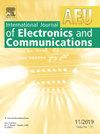用于sub-6 GHz 5G和IEEE 802.11ba/Be应用的机器学习辅助频率可重构同心圆谐振器启发天线
IF 3.2
3区 计算机科学
Q2 ENGINEERING, ELECTRICAL & ELECTRONIC
Aeu-International Journal of Electronics and Communications
Pub Date : 2025-06-13
DOI:10.1016/j.aeue.2025.155889
引用次数: 0
摘要
本研究提出了一种采用机器学习方法的宽带同心分环谐振器频率可重构天线,适用于5G (sub-6 GHz)和IEEE 802.11ba/Be应用。采用同心分裂环谐振腔和缺陷接地结构实现宽带宽。该天线覆盖1-1.2 GHz、1.2-1.5 GHz、1.5-1.7 GHz、3.8-5.2 GHz和4-5.3 GHz频段。该可重构天线采用两个PIN二极管(最大增益为6.2 dBi,最大辐射效率为96%),具有良好的调谐范围(99.18%)和总频谱(99.80%)。采用k近邻(KNN)、决策树(DT)、随机森林(RF)、极端梯度(XG) Boost、支持向量机(SVM)和人工神经网络(ANN)等6种回归ML算法对天线设计进行优化。在所有机器学习算法中,随机森林(RF)提供了最高的准确率,即99.30%,具有最大的R2分数和最小的均方误差(MSE)和所有开关配置的执行时间。此外,采用10倍交叉验证、配对t检验技术和SHAP分析来确保RF模型的准确性。利用Ansys HFSS仿真器对天线特性进行了研究,并与实验结果进行了比较,结果吻合较好。结果表明,该天线最适合于全球定位系统(GPS)、移动电话、Wi-Fi、WLAN、WiMAX、5G和IEEE 802.11 ba/Be通信等6 GHz以下的单频段和双频段应用。本文章由计算机程序翻译,如有差异,请以英文原文为准。
Machine learning assisted frequency reconfigurable concentric split ring resonator inspired antenna for sub-6 GHz 5G and IEEE 802.11ba/Be applications
This work proposed a wideband concentric split ring resonator frequency reconfigurable antenna using the machine learning approach for 5G (sub-6 GHz) and IEEE 802.11ba/Be applications. The concentric split ring resonator and defected ground structures are employed to achieve wide bandwidth. The proposed antenna covers 1–1.2 GHz, 1.2–1.5 GHz, 1.5–1.7 GHz, 3.8–5.2 GHz and 4–5.3 GHz frequency bands. The proposed reconfigurable antenna offers excellent tuning range (99.18%) and total spectrum (99.80%) by using two Positive-Intrinsic-Negative diode (PIN) diodes (with a maximum gain of 6.2 dBi and maximum radiation efficiency of 96%). Six regression ML algorithms such as K-nearest Neighbour (KNN), Decision Tree (DT), Random Forest (RF), Extreme Gradient (XG) Boost, Support Vector Machine (SVM) and Artificial Neural Network (ANN) are employed to optimize the antenna design. Among all ML algorithms, Random Forest (RF) provides the highest accuracy i.e. 99.30% with maximum score and minimum mean square error (MSE) and execution time for all switches configurations. Additionally, 10-fold cross-validation, paired t-test techniques and SHAP analysis are employed to ensure the accuracy of RF model. The antenna characteristics have been investigated using the Ansys HFSS simulator, and it is compared with the experimental results, which found to be in good agreement. These results indicates that the proposed antenna is best suitable for single-band and double-band sub-6 GHz applications such as Global Positioning System (GPS), mobile phones, Wi-Fi, WLAN, WiMAX, 5G and IEEE 802.11 ba/Be communication applications.
求助全文
通过发布文献求助,成功后即可免费获取论文全文。
去求助
来源期刊
CiteScore
6.90
自引率
18.80%
发文量
292
审稿时长
4.9 months
期刊介绍:
AEÜ is an international scientific journal which publishes both original works and invited tutorials. The journal''s scope covers all aspects of theory and design of circuits, systems and devices for electronics, signal processing, and communication, including:
signal and system theory, digital signal processing
network theory and circuit design
information theory, communication theory and techniques, modulation, source and channel coding
switching theory and techniques, communication protocols
optical communications
microwave theory and techniques, radar, sonar
antennas, wave propagation
AEÜ publishes full papers and letters with very short turn around time but a high standard review process. Review cycles are typically finished within twelve weeks by application of modern electronic communication facilities.

 求助内容:
求助内容: 应助结果提醒方式:
应助结果提醒方式:


